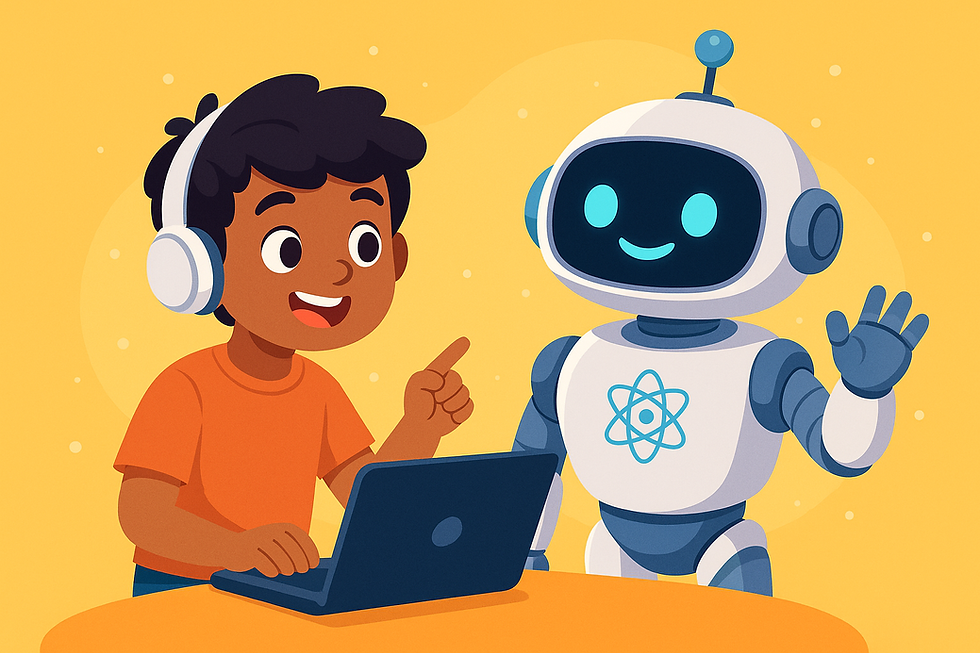Tech vs Kids: Are Gadgets Replacing Childhood ?
- Sandra Sabu
- Jul 30
- 3 min read

The sound of laughter in parks, scraped knees from cycling, bedtime stories told by grandparents—these were the moments that once defined childhood.
Today, they’re often replaced by glowing screens, YouTube videos, and mobile games. While technology is a powerful tool, the question we must ask is:
“Are gadgets silently replacing the essence of childhood?”
Technology today plays a major role in how children learn, play, and connect. It has the power to open doors to creativity, curiosity, and new skills—but only when used with purpose. The goal is to ensure that technology empowers kids, not enslaves them. It should be a tool for growth, not a source of distraction. Finding the right balance is essential. Platforms like LogicBox, India’s leading AI-based learning platform for kids, are working to create learning experiences that are engaging, safe, and development-focused—helping children make the most of technology in a positive way.
It’s undeniable that technology brings powerful advantages. Learning is now more interactive and personalized. Children can explore the solar system through simulations, build their first games using drag-and-drop coding tools, or solve math problems using gamified apps. Access to this kind of digital education helps young minds build critical thinking, creativity, and even early technical skills that prepare them for the future.
However, while these opportunities are incredible, they come with concerns that can’t be ignored. Many parents have noticed a shift—less time spent outdoors, reduced interest in traditional toys or books, and more time glued to screens. In some cases, toddlers are more fluent in tapping and swiping than in speaking complete sentences. School-aged children prefer mobile games over cycling with friends, and social media becomes a larger influence than real-life conversations.
The core of the issue isn’t technology itself—it’s how it’s used. Excessive screen time can interfere with sleep patterns, reduce attention span, and even lead to emotional and social challenges. Children are naturally curious and active. When screens dominate their time, it limits chances for real-world exploration, physical activity, and face-to-face social development, all of which are vital to a balanced childhood.
So, how can we find a middle ground?
Ultimately, childhood isn’t just about information—it’s about imagination, movement, relationships, and joy. Technology, when used with intention, can support all of these. But left unchecked, it can quietly push them aside. As parents, educators, and communities, the goal should be to help children become not just smart tech users, but also emotionally healthy, socially connected, and creatively alive individuals.
Let’s guide our children to use technology as a bridge to learning, not a wall that separates them from the beauty of growing up.
The Bright Side of Tech in Childhood
When used wisely, technology can transform how kids learn and grow. Platforms like LogicBox bring AI-powered learning to life, helping students from Grades 1 to 12 learn in fun, engaging, and interactive ways.
Here’s how tech is helping kids:
🎮 Gamified Learning: Learning becomes fun with quizzes, badges, and progress tracking.
🤖 Early Exposure to Coding & AI: Platforms like Scratch, Python, and AI tools are no longer for adults only.
🌍 Global Connectivity: Kids collaborate, share ideas, and access information from across the world.
🎨 Creative Outlets: Digital art, music creation, animation—tech gives kids endless ways to express themselves.
The Dark Side: When Tech Takes Over
However, when screen time goes unchecked, it can replace essential parts of a child’s development:
🚫 Reduced Physical Activity: Less time outdoors impacts health and motor skills.
😵💫 Shorter Attention Spans: Quick-reward content lowers patience for real-world learning.
😶🌫️ Loss of Face-to-Face Social Skills: Digital chat replaces playground interaction.
📵 Mental Health Issues: Overuse of devices links to anxiety, sleep disorders, and tech addiction.
A Parent’s Guide: Balancing Tech & Childhood
You don’t have to choose between gadgets and growth. Use these tips to help your child thrive with tech:
📵 Create Tech-Free Zones – No screens at the dinner table or before bed.
🎨 Encourage Offline Hobbies – Music, sports, painting—keep creativity alive offline too.
🧩 Choose Purposeful Platforms – Use apps like LogicBox that build knowledge, not just entertainment.
🕒 Set Screen Time Limits – Use timers and stick to routines.
💬 Talk About Tech – Ask your child what they watched or learned, not just how long they were online.
Tech is a Tool, Not a Substitute for Childhood
Gadgets are here to stay. The real challenge is how we use them. Do they replace connection, creativity, and curiosity, or do they amplify them?
At LogicBox, we believe that when guided with care, technology can unlock the brightest version of your child.
LogicBox – India’s Leading AI Learning Platform for Students
Let’s not raise screen addicts. Let’s raise future-ready creators.



Comments